I will start by blowing your mind. Below, same exact recipe for sourdough bread, with or without vitamin C added to the formula.
For the past year I’ve been playing with adding beets to bread, both using beet powder and roasted beets, but my experiments failed in the color department. Everything tasted pretty good, but the beautiful red color of beets was consistently lost during baking. I had resigned myself to brownish breads until I remembered using vitamin C to preserve the color of basil for freezing. Works like magic. Sorry, it is actually pure science. Vitamin C is a powerful anti-oxidant, and the browning reaction is simply oxidation of compounds during storage or cooking. I searched Google University and found out that others had already figured it all out and many bakers use vitamin C in their beet-containing breads.
RED BEET SOURDOUGH
(from the Bewitching Kitchen)
Comments: I was absolutely shocked by the results! You might think that the same outcome could be achieved by using some lemon or orange juice, as those fruits are loaded with vitamin C. It turns out that a whole lemon has about 20mg of vitamin C, so clearly not enough to do the job. I used purified ascorbic acid, borrowed from our lab, but I know home bakers use vitamin C tablets, usually each one contains 500 mg, so one or two tablets will be what you need. I intend to use that in the future and report back.
.
.
Same bread without vitamin C, nothing wrong with it, except that the beautiful red color is lost during baking. Even though, as you see in the composite below, until you put the bread in the oven, all seems totally fine.
.
.
And let me tell you, Red Beet Sourdough makes amazing croutons!
.
.
TWO YEARS AGO: Minnie-Macarons, a Fun Project with a Happy Ending
THREE YEARS AGO: Nigella Lawson in the Bewitching Kitchen
FOUR YEARS AGO: Walnut-Raisin Bran Muffins
FIVE YEARS AGO: Gingersnaps with White Chocolate Chips
SIX YEARS AGO: Turkey Chili with Almond Butter
SEVEN YEARS AGO: Secret Recipe Club: Leek and Cheese Tart
EIGHT YEARS AGO: Secret Recipe Club; Triple Chocolate Brownies
NINE YEARS AGO: Shaved Asparagus Salad
TEN YEARS AGO: Indonesian Ginger Chicken


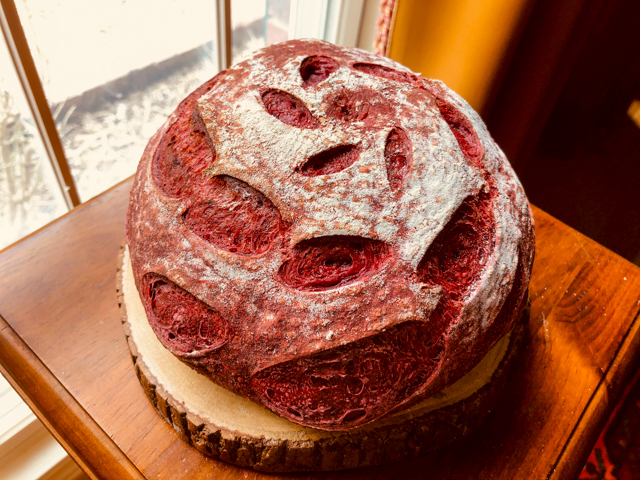
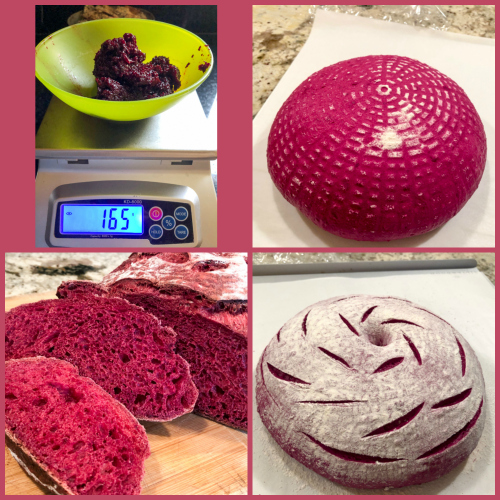

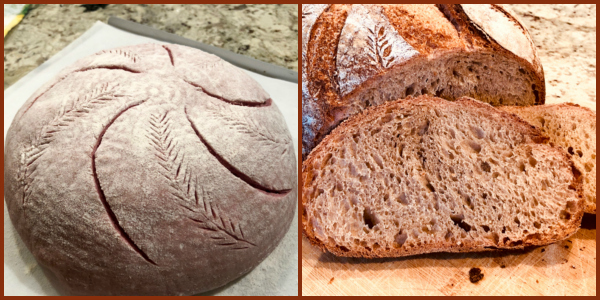
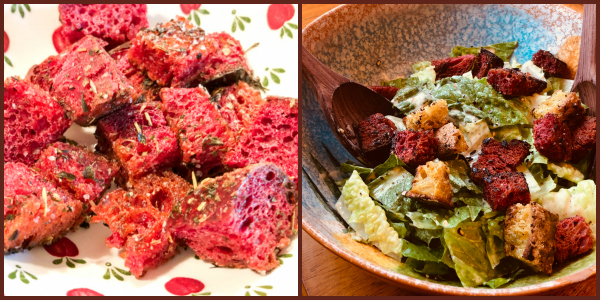
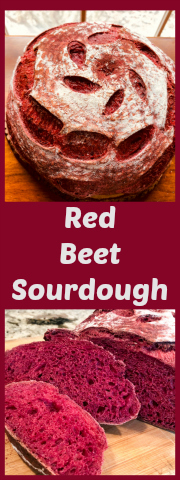
I’ve seen you comment on this before. I thought that this was less related to oxidation than to the chemical behind a beet’s color changing based upon pH (i. e. that it’s a pH indicator). Was I mistaken?
LikeLiked by 1 person
no in the case of beets is oxidation – butterfly pea flower is a pH induced change of color, but it’s not that it LOSES color in a certain pH, it simple goes from purple to blue.
LikeLike
Just to continue a bit on the subject – the idea of trying vitamin C on the butterfly pea bread is out of curiosity – it is possible that some oxidation also happens with the compounds that give the color, so maybe adding vitamin C the blue would be more evident (although I was happy enough with it when I made my blue-ish loaf). Vitamin C is a reasonably weak acid – I have not measured the pH of the final dough with or without it, but the change is quite likely negligible. However it is a powerful anti-oxidant
LikeLike
Gorgeous color, can you really taste the beets?
LikeLiked by 1 person
not really, it gave a kind of a deeper taste, but not exactly like beets… which is good because Phil does not care for them 😉
LikeLike
Pingback: Pa de remolatxa, de somni! – Cuinem!
Hi, I am confused in which amount of vitamin C I should use. Is it 1% of the flour or it’s just 1 gram? Also, did your dough was too hydrated? I mean because beetroot is mainly composed by water and also the rest of the water you added. Thank you!
LikeLike
I used a little less than 1 g – My dough was not terribly hydrated, I think it will depend on the beets you use, so if you think your beets are pretty “wet”, hold back on the water a bit and feel free to add more flour – I often adjust it a bit as I mix the dough, if it feels too loose I will sprinkle additional flour and go on from there.
LikeLike
Hi, I have a question about the amount of vitamin C you use. You say the correct amount is 0.9%. I would assume that you are using baker’s percentages and that would be 0.9% of the flour but the amount you use in your recipe doesn’t seem to be 0.9% of flour or any other ingredient. Perhaps you can clarify. BTW- your bread looks amazing. I can’t wait to try this out.
LikeLike
Hello there
I used 0.9g – my text with baker’s percentage was not right, so I just deleted it not to create confusion. It was around 0.2% in the end, as my starter is at 100% hydration, so using that amount of flour in the percentage calculation it comes to that.
LikeLike
Thank you for the fast response! I’m going to give this a shot today with 0.2% and see what happens.
LikeLiked by 1 person
awesome!!!!! let me know how it goes, sorry for the confusion
LikeLike
What about beetroot powder? How many grams of powder and vitamin C should I use? and when should I incorporate each?
LikeLiked by 1 person
I have used beet root powder only once in the past but did not couple with vitamin C, so I cannot tell, but I predict it will work. I add everything at the same time when I make the dough – as to the amount, it is written in the recipe, 0.9g – if you get vitamin tablets that are 500mg each, you can probably get by crushing one and a half tablets.
LikeLike
Thanks for your reply! How much beetroot powder would you recommend/did you use the last time? I don’t assume I would ass 162g of beetroot powder LOL
LikeLiked by 1 person
use*
LikeLike
oh no, definitely NOT! Ok, this will be slightly more complicated because the beet root will contribute a lot of moisture. I tell you what… go to this post… https://bewitchingkitchen.com/2021/02/25/peanut-charcoal-sourdough/ and use that as your basic method. Take 500g total flour (either all bread, or 475g bread, and 25g whole wheat, or spelt) – don’t use the charcoal, but add 10g beet powder + the vitamin C – proceed as the recipe tells you to – bake. Don’t get mad at me if it does not work!!!!!! but tell me about it, ok?
LikeLike
I would like to make sourdough beet pasta. Do you think the addition of Vitamin C would preserved the color vibrancy?
LikeLike
I think it would work – give it a try! if you do, please let me know how it worked!
LikeLike
Can you share how to use vitamin C to preserve the color of basil for freezing?
LikeLike
It’s been many many many years since I did that – I remember just eye-balling – I added a bunch of basil to the food processor and added 1 tablet of vitamin C – together with the oil and other suspects – worked great, I froze portions for a long time, it stayed super green
LikeLike